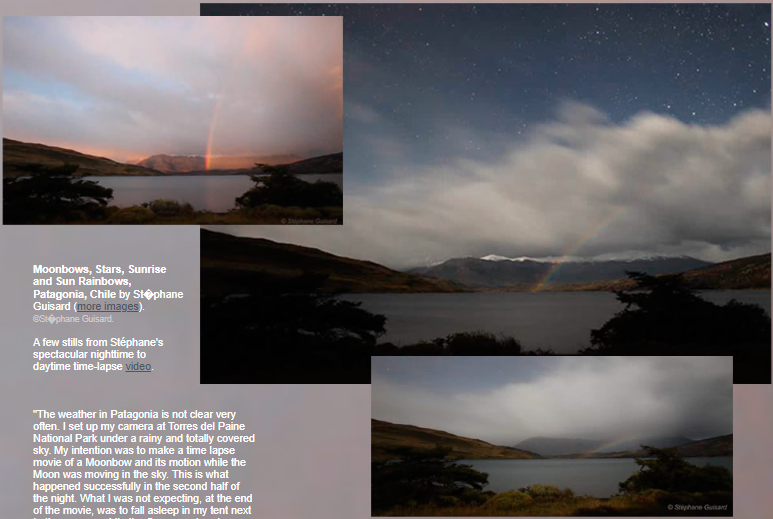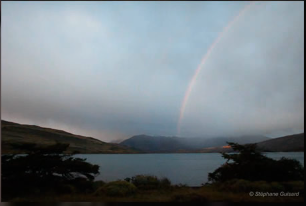Moonbows, stars, dawn, more rainbows.
Moonbows, Stars, Dawn, and More Rainbows: A Spectacular Display of Atmospheric Optics
Have you ever witnessed the breathtaking beauty of a moonbow? Or marveled at the sight of stars wheeling across the night sky, creating an ethereal backdrop for nature's light show? If not, then you're in for a treat. In this article, we'll explore the fascinating world of atmospheric optics and delve into the enchanting phenomena of moonbows, stars, dawn, and more rainbows.
The Magic of Moonbows
Moonbows, also known as lunar rainbows, are a rare and mesmerizing sight. They occur when moonlight refracts and reflects off water droplets in the air, creating a circular arc of colors in the night sky. Similar to rainbows, moonbows exhibit a spectrum of hues, ranging from vibrant reds on the outer edge to softer blues and purples on the inside. However, unlike rainbows that form in daylight, moonbows are often faint and pale due to the dimness of moonlight.
Moonbows in Patagonia
One particularly awe-inspiring display of moonbows took place in Patagonia, Chile. Photographer Stéphane Guisard captured the beauty of these celestial rainbows during a time-lapse video. Despite the typically cloudy weather in Patagonia, Guisard managed to capture the elusive moonbow motion as the moon traversed the sky. But what surprised him even more was waking up to witness a stunning "Sun rainbow" at sunrise. The video showcases the remarkable coexistence of both a moonbow and a sun rainbow in a single frame, offering viewers a truly magical experience.
Stars and Moonbows Dance in Harmony
As the night progresses, stars wheel across the sky, adding another layer of enchantment to the moonbow spectacle. With each passing moment, clouds and showers sweep across the heavens, creating even more moonbows. As the moon ascends higher, the moonbows descend lower, with the center of the rainbow directly opposite sinking. Eventually, when the moon reaches an elevation of more than 42°, the radius of the rainbow, no more moonbows are visible.
The Arrival of Dawn
As the stars dim and fade into the background, the sky begins to brighten with the approaching dawn. The sun slowly emerges on the horizon, casting a rosy pink glow on the westward clouds. This transition from night to day marks a shift in atmospheric optics, giving rise to a new array of visual wonders.
Dawn's Rainbow Symphony
With the rising sun comes a new wave of rainbows. The low-angle sunlight interacts with water droplets in the air, creating vivid red bows that grace the morning sky. Each rainbow gradually shifts southwards as the sun climbs towards the northern hemisphere in the Southern Hemisphere sky. This dance of light and color paints a mesmerizing picture, captivating all who witness it.
Capturing the Magic on Film
Photographer Stéphane Guisard's video, filmed with a 14mm lens on a Canon 5dII, beautifully captures the transition from night to day and the interplay between moonbows, stars, dawn, and more rainbows. The time-lapse footage showcases the ephemeral nature of these atmospheric phenomena, emphasizing their transient beauty and captivating allure.
Conclusion
Moonbows, stars, dawn, and more rainbows offer a captivating glimpse into the wonders of atmospheric optics. From the elusive beauty of moonbows to the mesmerizing dance of stars across the night sky, each moment presents a unique spectacle for those fortunate enough to witness it. The transition from night to day brings forth a symphony of color as the sun rises, casting its vibrant hues upon the world. So next time you find yourself beneath a moonlit sky or witnessing the break of dawn, take a moment to appreciate the magic that unfolds before your eyes—a testament to the wonders of our natural world.

Moonbows, Stars, Sunrise and Sun Rainbows, Patagonia, Chile by St�phane Guisard (more images). ©St�phane Guisard.
A few stills from Stéphane's spectacular nighttime to daytime time-lapse video.
"The weather in Patagonia is not clear very often. I set up my camera at Torres del Paine National Park under a rainy and totally covered sky. My intention was to make a time lapse movie of a Moonbow and its motion while the Moon was moving in the sky. This is what happened successfully in the second half of the night. What I was not expecting, at the end of the movie, was to fall asleep in my tent next to the camera while the Sun was already rising, showing also a nice classical "Sun rainbow" so that you can enjoy both a "Moon rainbow" and a "Sun rainbow moving on the same movie."
The top video still shows a moonbow made by the moon low in the east. The camera has caught the rainbow colours but the unaided eye mostly only sees a hint of them.
The stars wheel and clouds and showers cross the sky giving even more moonbows each getting lower and lower as the moon climbs and the centre of the rainbow directly opposite sinks. Eventually the moon is more than 42° high, the rainbow's radius, and no more bows are seen.
The wheeling stars dim and are hidden by the brightening sky of approaching dawn.
The sun rises, lighting the westward clouds rosy pink.
More bows appear, red from the low sun. Each bow shifts southwards as the sun climbs towards the north in the Southern Hemisphere sky.
Watch the video. Filmed with 14mm lens on a Canon 5dII.
More moonbows 1, 2, 3
Moonbow Challenge 1, 2


Note: this article has been automatically converted from the old site and may not appear as intended. You can find the original article here.
Reference Atmospheric Optics
If you use any of the definitions, information, or data presented on Atmospheric Optics, please copy the link or reference below to properly credit us as the reference source. Thank you!
-
<a href="https://atoptics.co.uk/blog/moonbows-stars-dawn-more-rainbows/">Moonbows, stars, dawn, more rainbows.</a>
-
"Moonbows, stars, dawn, more rainbows.". Atmospheric Optics. Accessed on November 26, 2024. https://atoptics.co.uk/blog/moonbows-stars-dawn-more-rainbows/.
-
"Moonbows, stars, dawn, more rainbows.". Atmospheric Optics, https://atoptics.co.uk/blog/moonbows-stars-dawn-more-rainbows/. Accessed 26 November, 2024
-
Moonbows, stars, dawn, more rainbows.. Atmospheric Optics. Retrieved from https://atoptics.co.uk/blog/moonbows-stars-dawn-more-rainbows/.